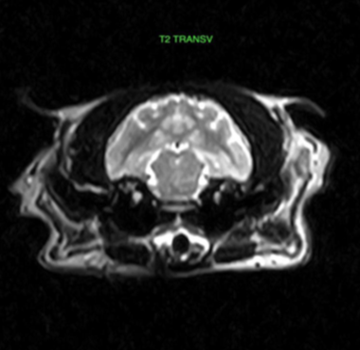The interfaces of feline idiopathic epilepsy
Case report from diagnosis to treatment
DOI:
https://doi.org/10.31533/pubvet.v19n02e1727Keywords:
cats, PhenobarbitalAbstract
Epilepsy consists of a neurological pathology that affects the central nervous system (CNS), characterized by clinical manifestations of convulsive crises and recurrent temporal paroxysmal episodes, and is idiopathic when its cause cannot be determined. This study aims to describe the association between the clinical signs of idiopathic epilepsy in a feline and the results of complementary exams. The animal received immediate post-crisis treatment, with supportive therapy being instituted. The administration of phenobarbital (40 mg/ml, 1-4 mg/kg every 12 hours) demonstrated efficacy in controlling seizures, with an absence of new generalized tonic-clonic seizures. The results suggest the importance of supportive care, and that the use of phenobarbital is effective in controlling seizures and stabilizing the patient's clinical condition.
References
Berg, A. T., Berkovic, S. F., Brodie, M. J., Buchhalter, J., Cross, J. H., Van Emde Boas, W., Engel, J., French, J., Glauser, T. A., Mathern, G. W., Moshé, S. L., Nordli, D., Plouin, P., & Scheffer, I. E. (2010). Revised terminology and concepts for organization of seizures and epilepsies: Report of the ILAE Commission on Classification and Terminology, 2005-2009. Epilepsia, 51(4), 676–685. https://doi.org/10.1111/j.1528-1167.2010.02522.x.
Carneiro, A. A., Hashizume, E. Y., & Elias, B. C. (2017). Epilepsia idiopática em cães. Revista Terra e Cultura, 33(1), 68–83.
Coates, J. R., & Wininger, F. A. (2010). Canine degenerative myelopathy. Veterinary Clinics: Small Animal Practice, 40(5), 929–950.
Coonheze, L., Ribeiro, R. M., & Ribeiro, D. S. F. (2021). Epilepsia idiopática em cães. Anais Colóquio Estadual de Pesquisa Multidisciplinar & Congresso Nacional de Pesquisa Multidisciplinar.
Devinsky, O. (2004). Terapia para distúrbios neurocomportamentais na epilepsia. Epilepsia, 45, 34–40.
Feitosa, F. L. F. (2014). Semiologia veterinária: A arte do diagnóstico. Roca Ltda.
Ferroni, L. O., Almeida Júnior, S. T., Moreira, G. S. S., Sousa, P. F., Bíscaro, I. S., & Belato, S. E. (2020). Epilepsia idiopática: Aspectos terapêuticos. Brazilian Journal of Development, 6(10), 76485–76501. https://doi.org/10.34117/bjdv6n10-173.
Garosi, L., & Lowrie, M. (2013). The neurological examination. In BSAVA Manual of Canine and Feline Neurology (pp. 1–24). BSAVA Library. https://doi.org/10.1093/ONS/OPZ066.
Hülsmeyer, V. I., Fischer, A., Mandigers, P. J. J., DeRisio, L., Berendt, M., Rusbridge, C., Bhatti, S. F. M., Pakozdy, A., Patterson, E. E., Platt, S., Packer, R. M. A., & Volk, H. A. (2015). International Veterinary Epilepsy Task Force’s current understanding of idiopathic epilepsy of genetic or suspected genetic origin in purebred dogs. BMC Veterinary Research, 11(1), 175. https://doi.org/10.1186/s12917-015-0463-0.
Kitz, S., Thalhammer, J. G., Glantschnigg, U., Wrzosek, M., Klang, A., Halasz, P., Shouse, M. N., & Pakozdy, A. (2017). Feline temporal lobe epilepsy: Review of the experimental literature. In Journal of Veterinary Internal Medicine, 31(3): 633–640. https://doi.org/10.1111/jvim.14699.
Laureano, S. A. A. M. (2009). Convulsões e Epilepsia em Cães. In Departamento de Vetrinária: Vol. Master of Sciences.
Lorenz, M. D., Coates, J. R., & Kent, M. (2011). Handbook of Veterinary Neuroanatomy. In Handbook of Veterinary Neurology.
Nascimento, F. T. B., Freitas, G. C., Oliveira, V. M., & Freitas, T. M. S. (2022). Epilepsia idiopática em cães: Novos tratamentos e impactos sobre os animais e tutores. PUBVET, 16(11), 1–11. https://doi.org/10.31533/pubvet.v16n11a1259.1-11.
Pakozdy, A., Halasz, P., & Klang, A. (2014). Epilepsy in cats: Theory and practice. Journal of Veterinary Internal Medicine, 28(2): 255–263. https://doi.org/10.1111/jvim.12297.
Platt, S. R., & Garosi, L. S. (2012). Small animal neurological emergencies. In Small Animal Neurological Emergencies. https://doi.org/10.1201/b15214.
Potschka, H., Fischer, A., Löscher, W., Patterson, N., Bhatti, S., Berendt, M., De Risio, L., Farquhar, R., Long, S., Mandigers, P., Matiasek, K., Muñana, K., Pakozdy, A., Penderis, J., Platt, S., Podell, M., Rusbridge, C., Stein, V., Tipold, A., & Volk, H. A. (2015). International veterinary epilepsy task force consensus proposal: Outcome of therapeutic interventions in canine and feline epilepsy. BMC Veterinary Research, 11(1), 177. https://doi.org/10.1186/s12917-015-0465-y.
Stanciu, G. D., Packer, R. M. A., Pakozdy, A., Solcan, G., & Volk, H. A. (2017). Clinical reasoning in feline epilepsy: Which combination of clinical information is useful? Veterinary Journal, 225, 9–12. https://doi.org/10.1016/j.tvjl.2017.04.001.

Downloads
Published
Issue
Section
License
Copyright (c) 2025 Andressa de Alcantara Serrano, Eduardo Alexandre de Oliveira, Junior Rodrigues da Silva, Ranya Rusche, Rebeca Pontes do Nascimento

This work is licensed under a Creative Commons Attribution 4.0 International License.
Você tem o direito de:
Compartilhar — copiar e redistribuir o material em qualquer suporte ou formato
Adaptar — remixar, transformar, e criar a partir do material para qualquer fim, mesmo que comercial.
O licenciante não pode revogar estes direitos desde que você respeite os termos da licença. De acordo com os termos seguintes:
Atribuição
— Você deve dar o crédito apropriado, prover um link para a licença e indicar se mudanças foram feitas. Você deve fazê-lo em qualquer circunstância razoável, mas de nenhuma maneira que sugira que o licenciante apoia você ou o seu uso. Sem restrições adicionais
— Você não pode aplicar termos jurídicos ou medidas de caráter tecnológico que restrinjam legalmente outros de fazerem algo que a licença permita.




